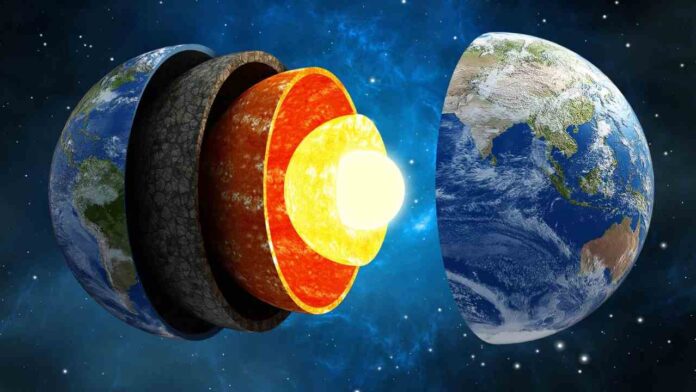The Earth is a layered marvel, akin to a terrestrial jawbreaker or spherical layer cake. Nested deep within, at the heart of our planet, lies the core. This region, composed of two distinct parts—a swirling, molten outer core and a mostly solid inner core—plays a pivotal role in the Earth’s geophysical processes.
The inner core, a dense sphere chiefly composed of iron and nickel, stretches around 1,200 kilometers in radius. Despite being subjected to scorching temperatures that could liquefy its constituent elements, the immense pressure at this depth counteracts the heat, rendering the inner core a solid sphere.
The core’s dynamism significantly contributes to the generation of our planet’s magnetic field. As the inner core cools and expands, it releases heat. This energy stirs the liquid metal in the outer core, creating a dynamo effect that transforms mechanical energy into magnetic energy. This dynamo generates the magnetic field that safeguards Earth from harmful solar radiation and atmospheric escape.
Understanding the idiosyncrasies of the core is critical, as even minute shifts in its behavior can precipitate discernible changes on the Earth’s surface. For instance, our day’s length can vary slightly due to these internal movements.
Inner Core Wobble: A Periodic Phenomenon
Recent research has revealed an intriguing aspect of the inner core’s behavior: it wobbles. This wobble, or oscillation, is not random but follows a specific pattern, occurring approximately every 8.5 years. This phenomenon is known as the Inner Core Wobble (ICW).
The ICW is akin to the motion of a spinning top that is gradually losing its balance. However, unlike a top that eventually topples over, the Earth’s inner core maintains its wobble in a steady cycle.
The discovery of this wobble provides valuable insights into the Earth’s internal dynamics and challenges traditional assumptions about the alignment and rotation of the Earth’s core and mantle.
Unraveling the Wobble: A Tilted Dance
The ICW is believed to result from a slight misalignment between the rotation axis of the inner core and that of the mantle. This misalignment, or static tilt, has been calculated to be about 0.17 degrees.
This tilt suggests that the northwestern hemisphere of the inner core might be slightly denser than the rest. Additionally, a sharper than expected density change exists at the boundary between the inner and outer core.
The static tilt and the uneven density within the core are thought to influence the flow of the liquid outer core, thereby shaping Earth’s magnetic field.
Observations and Analysis
The ICW was first flagged in 2019 when researchers noted a deviation in the polar motion—the movement of Earth’s rotational axis relative to its crust—occurring roughly every 8.5 years. This anomaly prompted further investigation into the Earth’s core dynamics.
Further research corroborated the ICW’s existence by measuring small shifts in the length of a day around the world. These measurements were then cross-referenced with the variations in polar motion previously identified.
Implications of the Inner Core Wobble
The revelation of ICW and its associated static tilt has profound implications for our understanding of the Earth’s rotation and density distribution.
The ICW’s periodicity, coupled with a discernible density change at the core-mantle boundary, offers valuable constraints for the 3D density model of the mantle. This information questions previously held beliefs about the Earth’s core and mantle’s alignment and rotation.
Moreover, the ICW’s ~8.5-year periodicity adds another layer to the Earth’s complexity. The periodic motion suggests a density shift of about 0.52 g/cm3 at the inner core boundary.
Future Research Directions
The unveiling of the ICW presents exciting opportunities for future research. Scientists aim to delve deeper into the Earth’s core’s stratified structure and density, exploring patterns and periods of core motion.
As our technology and understanding evolve, we can anticipate more fascinating discoveries about the heart of our planet, deepening our grasp of the hidden forces that shape our world.
Conclusion
The Earth’s core is a realm shrouded in mystery and intrigue. The recent discovery of the Inner Core Wobble adds another piece to the intricate puzzle of our planet’s inner workings. As we continue to probe the depths of our planet, we inch closer to unraveling the mysteries of Earth’s geology and understanding the forces that sculpt our world.
Reference:
Yachong An et al, Inner core static tilt inferred from intradecadal oscillation in the Earth’s rotation, Nature Communications (2023). DOI: 10.1038/s41467-023-43894-9.
